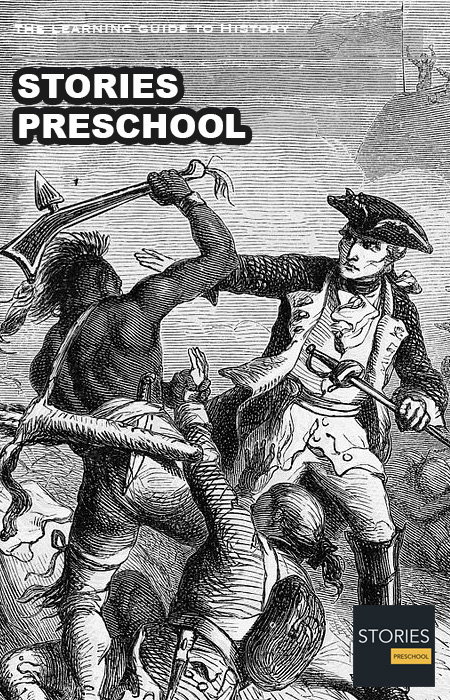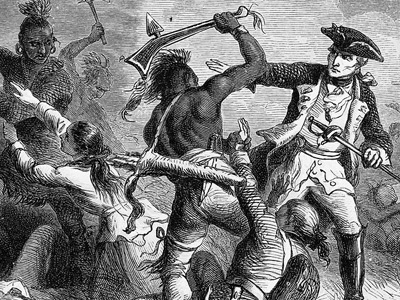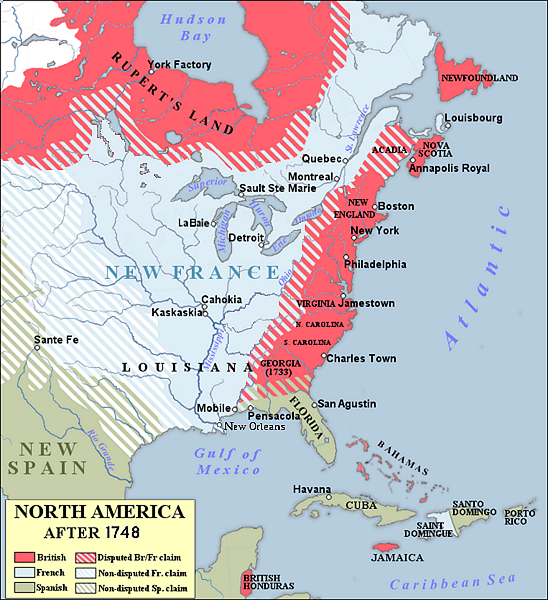French and Indian War (1754–1763)
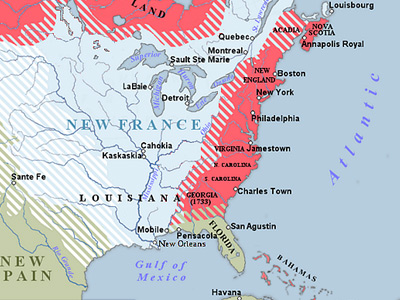
The French and Indian War (1754–1763) comprised the North American theater of the worldwide Seven Years' War of 1754–1763. The war pitted the colonies of British America against those of New France, with both sides supported by military units from their parent countries of Great Britain The Kingdom of Great Britain was a sovereign country in Western Europe from 1 May 1707 to the end of 31 December 1800. The state was created by the 1706 Treaty of Union and ratified by the Acts of Union 1707, which united the kingdoms of England (which included Wales) and Scotland to form a single kingdom encompassing the whole island of Great Britain and its outlying islands, with the exception of the Isle of Man and the Channel Islands. and France
The Kingdom of Great Britain was a sovereign country in Western Europe from 1 May 1707 to the end of 31 December 1800. The state was created by the 1706 Treaty of Union and ratified by the Acts of Union 1707, which united the kingdoms of England (which included Wales) and Scotland to form a single kingdom encompassing the whole island of Great Britain and its outlying islands, with the exception of the Isle of Man and the Channel Islands. and France The Kingdom of France is the historiographical name or umbrella term given to various political entities of France in the medieval and early modern period. It was one of the most powerful states in Europe since the High Middle Ages. It was also an early colonial power, with possessions around the world. Colonial conflicts with Great Britain led to the loss of much of its North American holdings by 1763. The Kingdom of France adopted a written constitution in 1791, but the Kingdom was abolished a year later and replaced with the First French Republic., as well as by Native American allies. At the start of the war, the French North American colonies had a population of roughly 60,000 European settlers, compared with 2 million in the British North American colonies. The outnumbered French particularly depended on the Indians. Following months of localised conflict, the metropole nations declared war on each other in 1756, escalating the war from a regional affair into an intercontinental conflict.
The Kingdom of France is the historiographical name or umbrella term given to various political entities of France in the medieval and early modern period. It was one of the most powerful states in Europe since the High Middle Ages. It was also an early colonial power, with possessions around the world. Colonial conflicts with Great Britain led to the loss of much of its North American holdings by 1763. The Kingdom of France adopted a written constitution in 1791, but the Kingdom was abolished a year later and replaced with the First French Republic., as well as by Native American allies. At the start of the war, the French North American colonies had a population of roughly 60,000 European settlers, compared with 2 million in the British North American colonies. The outnumbered French particularly depended on the Indians. Following months of localised conflict, the metropole nations declared war on each other in 1756, escalating the war from a regional affair into an intercontinental conflict.
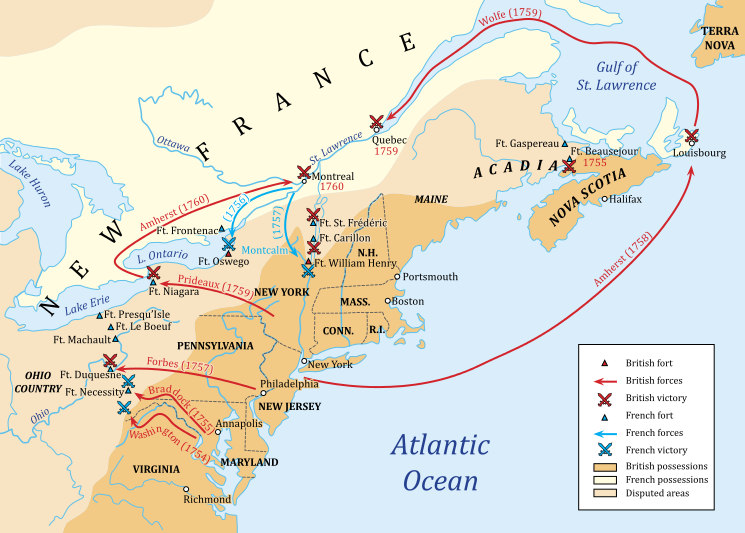
Map of the French and Indian War

Map of the French and Indian War
( Click image to enlarge)
The name French and Indian War, used mainly in the United States, refers to the two main enemies of the British colonists: the royal French forces and the various indigenous forces allied with them. British and European historians use the term the Seven Years' War, as do English speaking Canadians. French Canadians call it La guerre de la Conquête (the War of the Conquest) or (rarely) the Fourth Intercolonial War.
Fighting took place primarily along the frontiers between New France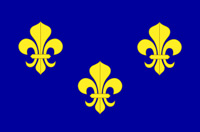 New France was the territory colonized by France in North America, beginning with the exploration of the Gulf of Saint Lawrence by Jacques Cartier in 1534 and ending with the cession of New France to Great Britain and Spain in 1763 under the Treaty of Paris. In the 16th century, the lands were used primarily to draw from the wealth of natural resources such as furs through trade with the various indigenous peoples. In the seventeenth century, successful settlements began in Acadia and in Quebec. and the British colonies, from Virginia in the south to Newfoundland in the north. It began with a dispute over control of the confluence of the Allegheny and Monongahela rivers, called the Forks of the Ohio, and the site of the French Fort Duquesne (within present-day Pittsburgh, Pennsylvania). The dispute erupted into violence in the Battle of Jumonville Glen in May 1754, during which Virginia militiamen under the command of 22-year-old George Washington ambushed a French patrol.
New France was the territory colonized by France in North America, beginning with the exploration of the Gulf of Saint Lawrence by Jacques Cartier in 1534 and ending with the cession of New France to Great Britain and Spain in 1763 under the Treaty of Paris. In the 16th century, the lands were used primarily to draw from the wealth of natural resources such as furs through trade with the various indigenous peoples. In the seventeenth century, successful settlements began in Acadia and in Quebec. and the British colonies, from Virginia in the south to Newfoundland in the north. It began with a dispute over control of the confluence of the Allegheny and Monongahela rivers, called the Forks of the Ohio, and the site of the French Fort Duquesne (within present-day Pittsburgh, Pennsylvania). The dispute erupted into violence in the Battle of Jumonville Glen in May 1754, during which Virginia militiamen under the command of 22-year-old George Washington ambushed a French patrol.
In 1755, six colonial governors in North America met with General Edward Braddock, the newly arrived British Army commander, and planned a four-way attack on the French. None succeeded, and the main effort by Braddock proved a disaster; he lost the Battle of the Monongahela on July 9, 1755 and died a few days later. British operations in 1755, 1756 and 1757 in the frontier areas of Pennsylvania and New York all failed, due to a combination of poor management, internal divisions, effective Canadian scouts, French regular forces, and Indian warrior allies. In 1755, the British captured Fort Beauséjour on the border separating Nova Scotia from Acadia; soon afterwards they ordered the expulsion of the Acadians (1755–1764). Orders for the deportation were given by William Shirley, Commander-in-Chief, North America, without direction from Great Britain. The Acadians, both those captured in arms and those who had sworn the loyalty oath to His Britannic Majesty, were expelled. Native Americans were likewise driven off their land to make way for settlers from New England.
After the disastrous 1757 British campaigns (resulting in a failed expedition against Louisbourg and the Siege of Fort William Henry, which was followed by Indian torture and massacres of British victims), the British government fell. William Pitt came to power and significantly increased British military resources in the colonies at a time when France was unwilling to risk large convoys to aid the limited forces it had in New France. France concentrated its forces against Prussia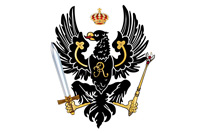 The Kingdom of Prussia was a German kingdom that constituted the state of Prussia between 1701 and 1918. It was the driving force behind the unification of Germany in 1871 and was the leading state of the German Empire until its dissolution in 1918. Although it took its name from the region called Prussia, it was based in the Margraviate of Brandenburg. Its capital was Berlin. and its allies in the European theatre of the war. Between 1758 and 1760, the British military launched a campaign to capture the Colony of Canada. They succeeded in capturing territory in surrounding colonies and ultimately the city of Quebec (1759). Though the British later lost the Battle of Sainte-Foy west of Quebec (1760), the French ceded Canada in accordance with the Treaty of Paris (1763).
The Kingdom of Prussia was a German kingdom that constituted the state of Prussia between 1701 and 1918. It was the driving force behind the unification of Germany in 1871 and was the leading state of the German Empire until its dissolution in 1918. Although it took its name from the region called Prussia, it was based in the Margraviate of Brandenburg. Its capital was Berlin. and its allies in the European theatre of the war. Between 1758 and 1760, the British military launched a campaign to capture the Colony of Canada. They succeeded in capturing territory in surrounding colonies and ultimately the city of Quebec (1759). Though the British later lost the Battle of Sainte-Foy west of Quebec (1760), the French ceded Canada in accordance with the Treaty of Paris (1763).
The outcome was one of the most significant developments in a century of Anglo-French conflict. France ceded its territory east of the Mississippi to Great Britain. It ceded French Louisiana west of the Mississippi River (including New Orleans) to its ally Spain The Spanish Empire was a colonial empire governed by Spain and its predecessor states between 1492 and 1976. One of the largest empires in history, it was the first to usher the European Age of Discovery and achieve a global scale, controlling vast territory. It was one of the most powerful empires of the early modern period, reaching its maximum extent in the 18th century., in compensation for Spain's loss to Britain of Florida (Spain had ceded Florida to Britain in exchange for the return of Havana, Cuba). France's colonial presence north of the Caribbean was reduced to the islands of Saint Pierre and Miquelon, confirming Great Britain's position as the dominant colonial power in eastern North America.
The Spanish Empire was a colonial empire governed by Spain and its predecessor states between 1492 and 1976. One of the largest empires in history, it was the first to usher the European Age of Discovery and achieve a global scale, controlling vast territory. It was one of the most powerful empires of the early modern period, reaching its maximum extent in the 18th century., in compensation for Spain's loss to Britain of Florida (Spain had ceded Florida to Britain in exchange for the return of Havana, Cuba). France's colonial presence north of the Caribbean was reduced to the islands of Saint Pierre and Miquelon, confirming Great Britain's position as the dominant colonial power in eastern North America.
HISTORY
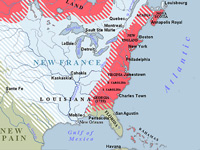
RESOURCES
This article uses material from the Wikipedia article "French and Indian War", which is released under the Creative Commons Attribution-Share-Alike License 3.0.
© Stories Preschool. All Rights Reserved.
